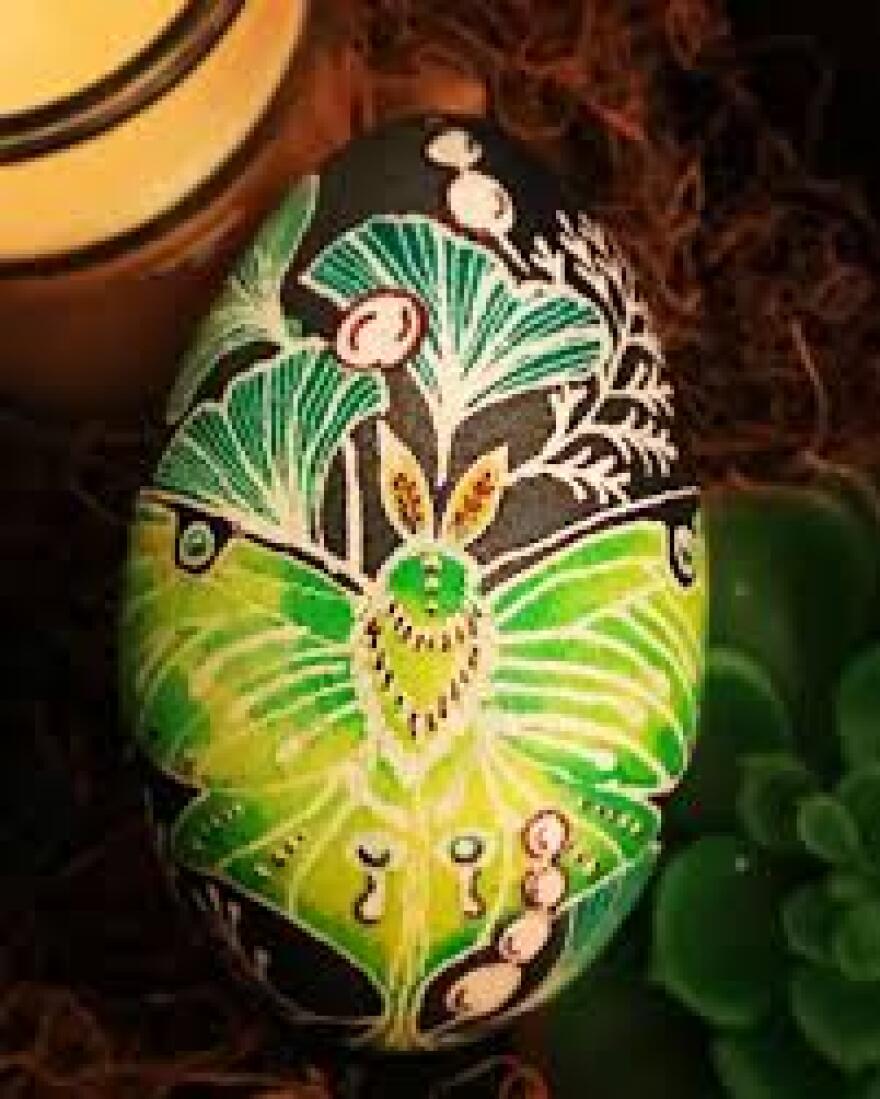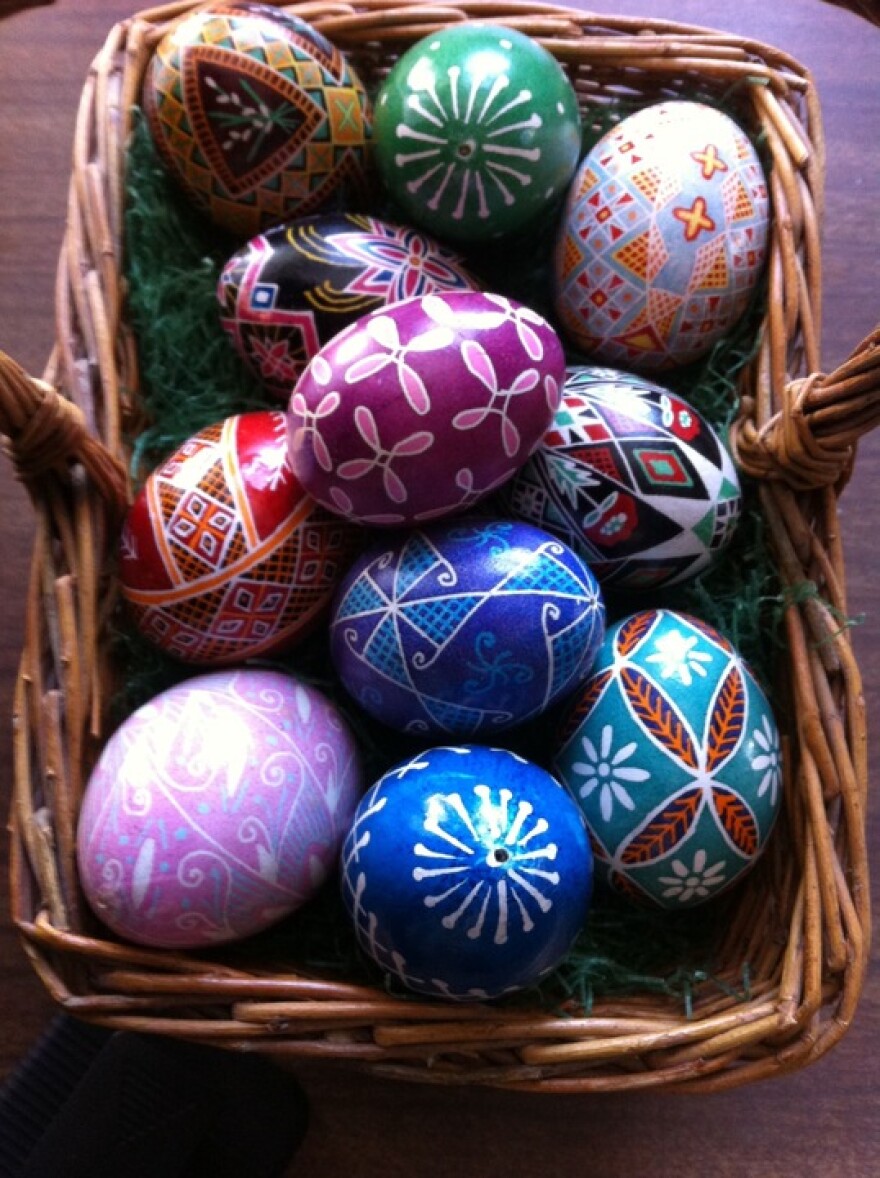LEHIGHTON, Pa. — Kerry Palumbo held onto the small tool, or kistka, as she demonstrated how to draw lines onto an egg, dipping it with beeswax, and then into jars of colored dyes.
It was not your average-looking Easter egg.
At Within Harmony, a crystal and holistic gift shop on South First Street in Lehighton, Palumbo taught a small group of people how to create a pysanky egg.
Pysanky is an ancient Ukrainian folk tradition that dates back more than 2,000 years.
In 988, it was adapted to Christianity and is celebrated during Orthodox Easter, which this year falls on May 5.
Typically, the decorated eggs are placed in baskets and handed out as gifts after Easter Mass.
Gifts of good luck
Though a tradition of Ukrainian Orthodox Christians, pysanky comes from the Ukrainian word "to write" and stems from pagan customs.
Legend holds that evil in the form of a dragon-like monster will spread through the world unless the pysanky are decorated and gifted.
In a year when many eggs are made, the dragon — or evil — is held at bay.
"The history is that they were always done to be given away. When women in Ukraine and other parts of Eastern Europe would sit down to make these eggs, they were making them for the community."Kerry Palumbo
"The history is that they were always done to be given away," Palumbo said.
"When women in Ukraine and other parts of Eastern Europe would sit down to make these eggs, they were making them for the community.
"They were buried in fields and under the house. They were put in rafters of barns. They were put under the beehive. They were given by girls to the boys that they were interested in."
The eggs, intricate in design and detail, were symbolic of springtime and good fortune.
"As you worked on the egg and you wrote these symbols into the egg that had a meaning — that had an intention behind them — you were putting a piece of yourself, a little bit of your energy, your soul, into that living being and living object," Palumbo said.
"And so when you gifted those away, you never emptied the contents. You were supposed to be gifting a piece of yourself to whatever the intention was."
Healing eggs
Palumbo was taught pysanky by her great-aunt Irene, who also taught her mother.
"My sister and I were totally fascinated watching them do the eggs and kept begging [to learn] and finally they relented," Palumbo said.

"My mom bought kits and we would do it as a family, usually during the 40 days of Lent.
"But the big deal for us as kids was on Good Friday. That was like the only thing we were allowed to do during the three hours of the Passion of Christ."
Palumbo, an English teacher at Palmerton Area High School, had put the tradition on hold for years, but when her daughter was diagnosed with a brain tumor at age 11, she turned back toward the art.
As her daughter, who is now 23, was involved with physical and occupational therapy, Palumbo decided to teach her how to decorate the eggs.
"My daughter had to re-learn to do everything with her non-dominant hand," she said.
"And so making pysanky is working with fine motor skills and sitting down and making eggs — it's like your brain disengages with all of the worries and all the problems in the world.
"It has become a very personal, prayerful, ritualistic practice for me. I try to work on my eggs at least a little bit every day, but I have to be in the right state. It's not something I can do if I've had a bad day or I'm frustrated over something. I have to clear my mind and energy, and then I can work on my egg."Kerry Palumbo
"It was a huge part of her occupational therapy and her ability to gain fine motor skills in her non-dominant side."
About 10 years ago, after she had posted pictures of her eggs on social media — and received overwhelming praise — Palumbo decided to teach a course on the ancient custom.
"After the war in Ukraine started, there was this resurgence of interest in the craft and the art," Palumbo said. "It has become a very personal, prayerful, ritualistic practice for me.
"I try to work on my eggs at least a little bit every day, but I have to be in the right state. It's not something I can do if I've had a bad day or I'm frustrated over something.
"I have to clear my mind and energy, and then I can work on my egg."
A 'region' of designs
John Drozd has been a pysanky artist for 50 years.
This year, he taught about 15 parishioners at Holy Ghost Ukrainian Catholic Church in West Easton and 30 more people at a parish in Swarthmore in suburban Philadelphia.
"I think it's great that people are learning it now and passing down their traditions, because sometimes those kinds of traditions, they don't switch over," Drozd said.

Psyanky art varies by region, he said.
On his paternal side, his family emigrated from western Ukraine to the United States after World War II, he said.
"My mom's parents immigrated in the early 1900s, and where my grandmother was from, they did a simpler design," he said.
"It was just, it was called drop and drag. You put a drop of wax on the egg and then you dragged it to the center point and you created designs that way.
"It's nice to share part of my culture and my ancestors traditions."John Drozd
"They were usually only dyed one color. My mom and my aunt both took classes. They had gone to someone else and learned from them how to do the more intricate eggs.
"They make eggs all over Ukraine. There are certain designs that are specific to a region and there are certain colors that would be specific to a region."
In his classes, Drozd speaks of the meaning of the different designs drawn on the eggs.
"When Ukraine was Christianized in 988, all of the colors and the designs took on Christian meanings," he said. "I usually go into a little bit of what the different designs mean, what the different colors mean, to give [the class] a little bit of a history.
Besides the art technique, Drozd said he finds people also enjoy learning about the history of the craft, too.
"It's nice to share part of my culture and my ancestors traditions," he said.


